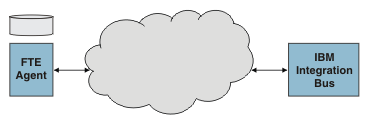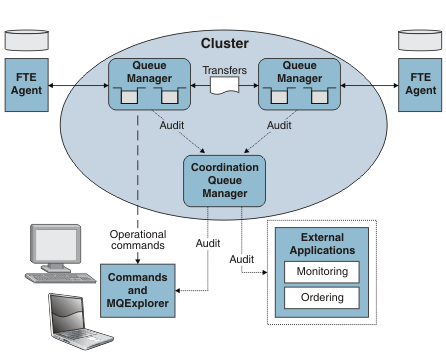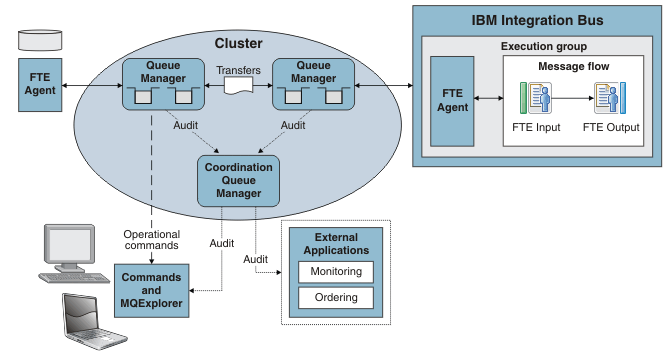
- Transfer metadata is supported, providing more flexible file processing.
- Transfers are timely.
- The audit trail is complete between the broker and the remote agent.
- Resource statistics are available.
About WebSphere MQ File Transfer Edition
WebSphere® MQ File Transfer Edition V7.0 delivers a reliable managed file transfer solution for moving files between IT systems without the need for programming. Files that are larger than the maximum individual WebSphere MQ message size can be moved. A log of file movements demonstrates that business data in files is transferred with integrity from source file system to destination file system.
Using the WebSphere MQ File Transfer Edition nodes offers seamless integration with your existing WebSphere MQ File Transfer Edition network. The following diagram shows a typical WebSphere MQ File Transfer Edition network:

- agent
- A process that forms the end point of a transfer (source or destination). An agent is a WebSphere MQ application, and is connected to one queue manager. Many agents can be connected to the same queue manager. Operational commands can be sent to an agent (for example, to request a transfer) by putting an XML message on a particular queue on the agent's queue manager.
- coordination queue manager
- One queue manager in the topology takes on the responsibility of the coordination queue manager. All agents register with the coordination queue manager and also send audit information about each transfer. The coordination queue manager is responsible for publishing that audit information to external monitoring applications.
- transfer
- A transfer is a movement of one or more files from one agent to another. The transfer goes direct from one agent's queue manager to the other agent's queue manager, not via the coordination queue manager. The transfer takes place even if the coordination queue manager is not running.
- transfer log
- The WebSphere MQ Explorer plug-in tool includes a Transfer Log view that subscribes to the coordination queue manager for the audit information. The view displays information about every transfer that occurs in a given topology.
How IBM Integration Bus fits in

- agent
An agent runs in each integration server that has deployed flows containing WebSphere MQ File Transfer Edition nodes. The agent is responsible for receiving and initiating all WebSphere MQ File Transfer Edition transfers. The agent name is derived from Broker.IntegrationServer; the name is not configurable. See Preparing the environment for WebSphere MQ File Transfer Edition nodes for restrictions on agent names.
You do not need to start or stop this agent; if a flow containing WebSphere MQ File Transfer Edition nodes is deployed, the agent is running. The agent is stopped only when the integration server is stopped. The broker queue manager is used as the queue manager for the agent.
- coordination queue manager
The broker queue manager is the default coordination queue manager. You can specify a different coordination queue manager by using the IBM® Integration Explorer, or the mqsichangeproperties command. You must configure your coordination queue manager as a coordination queue manager. See the
 WebSphere File Transfer Edition product documentation for
details.
WebSphere File Transfer Edition product documentation for
details. - transfer
Multiple FTEOutput nodes can be deployed to the same integration server, or to different integration servers in the same broker. FTEOutput nodes can send one file per transfer. Each file can have multiple records. Each record can have multiple elements. Transfers from the FTEOutput are non-blocking; an error occurs if another transfer is outstanding with the same file name.
Multiple FTEInput nodes can be deployed to the same integration server, or to different integration servers in the same broker. Multiple FTEInput nodes can read files transferred to the same directory without contention. Each file is processed only once, even if the nodes are deployed to separate integration servers, or different brokers.
When sending a file, you can dynamically set the following properties:- Destination agent
- Destination file directory
- Destination file name
- Destination queue manager
- Job name
- Overwrite files on destination
When receiving files, you can apply filters. If an integration server has more than one FTEInput node, each node receives only the appropriate files. You can also determine what happens after the file has been processed (the file is left in its existing destination directory, left with a timestamp added, or deleted). See the Basic tab on the node for details. FTEInput nodes can only process transfers where the destination is a file. If the embedded FTE agent receives a transfer where the destination is a queue, that transfer will be ignored, and will not be processed by any deployed FTEInput nodes.
You can combine the FTEInput and FTEOutput nodes to create a request and reply flow. See the sample for details.
Using elements in the local environment, you can call a program on the destination agent before starting the transfer, or when the transfer is finished. See LocalEnvironment.Destination.FTE fields for details.
Overview of using WebSphere MQ File Transfer Edition nodes
You do not need to configure the WebSphere MQ File Transfer Edition code that runs in the broker. Operational tools in IBM Integration Explorer are provided to create transfers. The following nodes are provided:- FTEOutput
- FTEInput
- Create a flow that includes one of the WebSphere MQ File Transfer Edition nodes.
- Configure the node.
- For production purposes, change the coordination queue manager from the broker queue manager; see Preparing the environment for WebSphere MQ File Transfer Edition nodes.
- Deploy the flow.
Monitoring the license usage of WebSphere MQ File Transfer Edition in IBM Integration Bus
A message is written to the system log for every integration server that has a WebSphere MQ File Transfer Edition node deployed.
 Last updated Friday, 21 July 2017
Last updated Friday, 21 July 2017